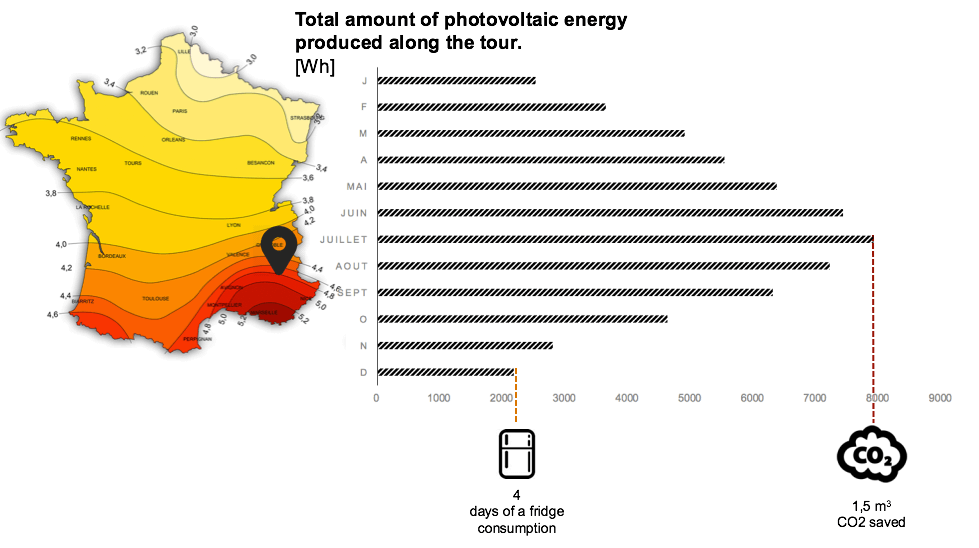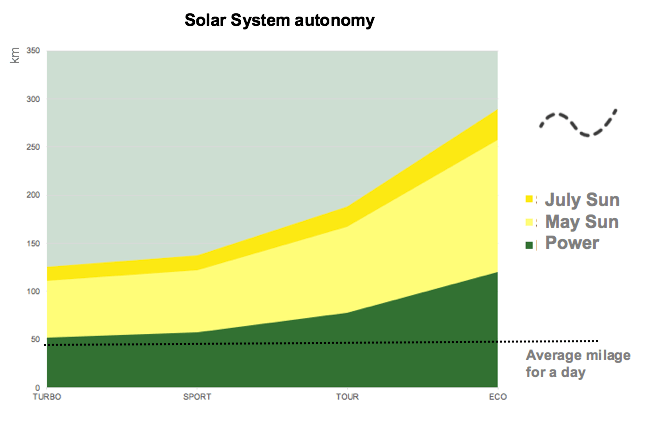Let’s have a look at Aventures Solaires concept from a technological point of view, and discover the main elements that make up our Solar Bike.
> The bike and its electric motor
Everything starts with a powerful electrically assisted bike, which has a 36V brushless motor with an output of 250W. This motor is located in the bottom bracket so that its efficiency is based on the pedaling frequency and not on the speed of the bike. Thus the motor is effective even at low and moderate speeds, which is ideal to cycle in mountains. The motor provides proportional assistance through a torque sensor also located in the bottom bracket. It multiplies the power of pedaling by a factor dependent on the assistance mode selected : ECO mode, TOUR, SPORT, or TURBO as shown on the figure below :
The assistance is effective up to 25 km per hour, according with European legislation. Beyond this speed, it cuts very gradually. But it doesn’t prevent you going faster downhill for example, or pedaling harder in !
> The trailer
This is the part which embeds the solar charger. It is a single-wheel trailer, suspended for both rider and photovoltaic modules comfort. It also hosts a 90L waterproof bag to take all the stuff you need during the tour and provide logistical autonomy.
> The photovoltaic modules
This is the core of our solar bike, since they ensure conversion of solar energy into electrical energy. The selected modules are monocrystalline technology modules, called “back contact”: the electrical contacts are on the back of the solar panel and so do not ombrent the cells, resulting in the best area efficiency on the market (> 20% ) and also minimizes the clutter.
These modules operate with a voltage between 17 and 19V, therefore we’ll have to raise their tension, as discussed below.
The installed output of the Solar Bike is 200Wc *, split into two panels of 100Wc each. 100Wc are always available (even during cycling) and additional 100Wc is deployed off during pauses. If properly exposed, the modules can produce more than 1000Wh every day during the “Tour des Ecrins”. This excellent performance can be reach because of the exceptional amount of sunshine in this area.
*Wc measures the power of a single module at 25 ° C and irradiation of 1000W/m²
> Solar Controller
This is the brain of the system that performs two different functions : optimize the amount of energy produced by the photovoltaic modules in adapting their electrical voltage to the light conditions via a control MPPT ( Maximum Power Point Tracking) and convert module voltage ( 17-19V ) to the battery charging voltage ( 36-42V )
> Batteries
Lithium -ion batteries have, as the engine, a rated voltage of 36V and a capacity of 800Wh. They act as buffer between modules and the engine. Batteries deliver the exact power requested by the cyclist while storing solar energy to return it at the appropriate time. Incidentally they can be charged into the mains in case of very clowdy day, so that you start the day after with two fully charged batteries.
You are now ready to hit the road on your Solar bike, in a total autonomy as regards logistical or energetic issues.
Let the sun gives you a ride !





